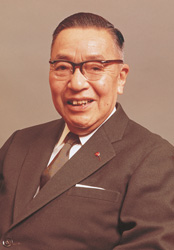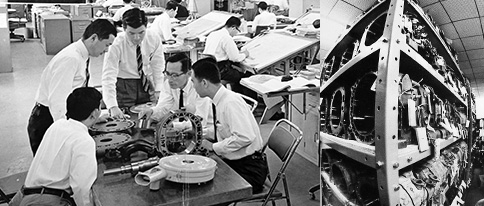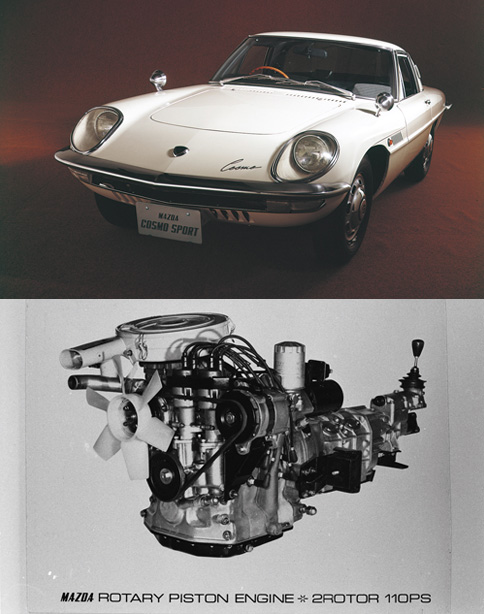Chapter I
Opening a New Frontier with the Rotary Engine
In the early 1960s, Mazda (which was called Toyo Kogyo at that time) faced a formidable challenge: to become more competitive in terms of both technology and product development so that it could survive and expand globally amid the increasingly competitive automotive market. Around that time, the rotary engine, which combines a simple structure, light weight and compact size with quietness and high power, was drawing attention from carmakers around the world as a dream technology. Tsuneji Matsuda, who was Mazda’s president at that time, believed that the company needed to develop a unique technology if it was to survive and set the goal of commercializing the rotary engine ahead of other companies.
The road to the commercialization proved to be rocky, however.

Tsuneji Matsuda, president in the early 1960s
There were several types of rotary engine under development around the world, from among which Mazda adopted the Wankel variety. To acquire knowhow, Mazda sent a team of engineers to a West German company called NSU. There, the team found that there was a huge technological obstacle to the development in the form of “chatter marks.”
The Wankel rotary engine is characterized by the unique triangular shape of its rotor. As the rotor turns at high speed, the apex seal, which is attached to each apex of the triangle to ensure air tightness, undergoes friction with the inside surface of the cocoon-shaped rotor housing.
This process causes abnormal wear on the chrome plating finish within hours, leaving traces called “chatter marks,” which are also known as the Devil’s nail marks. Finding a way to avoid such damage was critical to the development of a practical rotary engine.

left: A prototype engine imported from NSU
right:Chatter marks

left:Engineers working to develop a rotary engine
right:Prototype engines
To tackle the challenge, Mazda assembled a team of 47 young engineers, who formed a rotary engine research department. Kenichi Yamamoto, the head of the department, compared the mission of the engineers, who were venturing into the uncharted territory of rotary engine commercialization, to that of the Shijyu Shichi Shi. The Shijyu Shichi Shi is a legendary band of 47 samurai warriors who dedicated their lives, with unparalleled loyalty and perseverance, to the cause of avenging what they saw as the unjust death of their master. Yamamoto told the engineers: “From now on, the rotary engine must be on your minds at all times, whether you are sleeping or awake.”
In search of a solution, the engineers tried every conceivable thing – including horse and cow bones – as an apex seal material. However, they remained unable to resolve the chatter mark problem. The impasse fueled skepticism in academic and industrial circles about the chances of Mazda succeeding in developing a practical rotary engine. Moreover, within Mazda, the rotary engine project came to be viewed as a waste of money. The development team, though consumed by a sense of uncertainty and impatience, persevered in their aspiration toward commercialization of the dream technology.

upper:Cosmo Sport
lower:The world's first mass-production two-rotor rotary engine
At long last, the team achieved a breakthrough in 1963, when an engineer proposed the idea of changing the apex seal’s frequency characteristics by modifying its shape. A cross-hollow seal with a cross-shaped hole near the apex of the seal was developed and tested. The test proved successful, with no chatter marks appearing on the inside surface of the engine. In the following year, with the support of Nippon Carbon Co., Ltd., Mazda created a new apex seal made from aluminum-carbon composite materials. This innovation opened the way for bringing rotary engine-powered cars to the street.
The Cosmo Sport was Mazda’s first rotary engine-powered car. Designed right from the start to be driven by a rotary engine, the Cosmo Sport featured an unconventional styling that created a buzz.
Before the launch of the Cosmo Sport, trial rides were organized at car dealers across Japan to evaluate the new car’s performance, at the suggestion of President Matsuda. “With the cooperation of dealers, we will be able to obtain practical, useful data. If we fail after coming this far, it will be said that “the rotary engine is useless.” That would be regrettable,” Matsuda said. As problems reported from dealers were resolved one after another, the engine moved step-by-step closer to commercialization.
On May 30, 1967, the Cosmo Sport was premiered, marking the debut of the world’s first mass production car powered by a two-rotor rotary engine. That was the moment when the Mazda samurai’s resolution and tenacity as well as their innovative ideas came to fruition.

